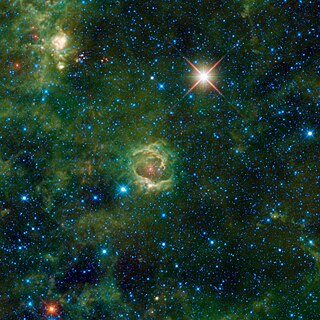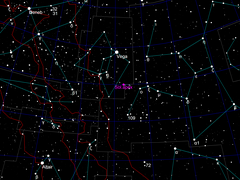
Proper motion is the astrometric measure of the observed changes in the apparent places of stars or other celestial objects in the sky, as seen from the center of mass of the Solar System, compared to the abstract background of the more distant stars.

Hipparcos was a scientific satellite of the European Space Agency (ESA), launched in 1989 and operated until 1993. It was the first space experiment devoted to precision astrometry, the accurate measurement of the positions of celestial objects on the sky. This permitted the first high-precision measurements of the intrinsic brightnesses, proper motions, and parallaxes of stars, enabling better calculations of their distance and tangential velocity. When combined with radial velocity measurements from spectroscopy, astrophysicists were able to finally measure all six quantities needed to determine the motion of stars. The resulting Hipparcos Catalogue, a high-precision catalogue of more than 118,200 stars, was published in 1997. The lower-precision Tycho Catalogue of more than a million stars was published at the same time, while the enhanced Tycho-2 Catalogue of 2.5 million stars was published in 2000. Hipparcos' follow-up mission, Gaia, was launched in 2013.

Zeta Reticuli, Latinized from ζ Reticuli, is a wide binary star system in the southern constellation of Reticulum. From the southern hemisphere the pair can be seen with the naked eye as a double star in very dark skies. Based upon parallax measurements, this system is located at a distance of about 39.3 light-years from Earth. Both stars are solar analogs that have characteristics similar to those of the Sun. They belong to the Zeta Herculis Moving Group of co-moving stars that share a common origin.

Mu Cephei, also known as Herschel's Garnet Star, Erakis, or HD 206936, is a red supergiant or hypergiant star in the constellation Cepheus. It appears garnet red and is located at the edge of the IC 1396 nebula. Since 1943, the spectrum of this star has served as a spectral standard by which other stars are classified.

Zeta Tucanae, Latinized from ζ Tucanae, is a star in the constellation Tucana. It is a spectral class F9.5 main sequence star with an apparent magnitude of +4.23. Despite having a slightly lower mass, this star is more luminous than the Sun. Based upon parallax measurements by the Hipparcos spacecraft, it is approximately 28.0 light years from Earth. This is one of the least variable stars observed during the Hipparcos mission.

Xi2 Centauri, Latinized from ξ2 Centauri, is a triple star system in the southern constellation of Centaurus. It is visible to the naked eye with an apparent visual magnitude of 4.30, and forms a wide optical double with the slightly dimmer ξ1 Centauri. Based upon an annual parallax shift of 6.98 mas, Xi2 Centauri lies roughly 470 light years from the Sun. At that distance, the visual magnitude is diminished by an interstellar extinction factor of 0.32 due to intervening dust.
Iota Geminorum is a solitary fourth-magnitude star in the constellation Gemini. In the sky, it forms an isosceles triangle with Castor and Pollux, and is located less than a degree from the 5th magnitude stars 64 and 65 Geminorum.
In astronomy, the local standard of rest or LSR is a reference frame which follows the mean motion of material in the Milky Way in the neighborhood of the Sun, on average sharing the same velocity around the Milky Way as the Sun. The path of this material is not precisely circular. The Sun follows the solar circle at a speed of about 255 km/s in a clockwise direction when viewed from the galactic north pole at a radius of ≈ 8.34 kpc about the center of the galaxy near Sgr A*, and has only a slight motion, towards the solar apex, relative to the LSR.

Omicron Herculis, Latinized from o Herculis, is a star in the constellation Hercules. It used to be called Masym, but this name was transferred to Lambda Herculis.

Gamma Reticuli is a solitary star in the southern constellation of Reticulum. With an apparent visual magnitude of 4.5, it can be faintly seen with the naked eye. Based upon an annual parallax shift of 6.95 mas, it is located roughly 469 light years from the Sun. At that distance, the visual magnitude is diminished by an extinction factor of 0.08 due to interstellar dust.

Eta Reticuli, Latinized from η Reticuli, is a solitary star in the southern constellation of Reticulum. With an apparent visual magnitude of 5.22, it is faintly visible to the naked eye on a dark night. Based upon an annual parallax shift of 8.48 mas, it is located at a distance of roughly 385 light years from the Sun. It may be a member of the high-velocity Zeta Herculis Moving Group of stars that share a common motion through space.

Epsilon Pyxidis (ε Pyxidis) is quadruple star system in the southern constellation of Pyxis. It is faintly visible to the naked eye, having a combined apparent visual magnitude of +5.60. Based upon an annual parallax shift of 15.39 mas as seen from Earth, it is located around 212 light years from the Sun. The system is deemed to be a member of the Sirius supercluster of stars that share a common motion through space.
HD 114837 is a suspected binary star system in the southern constellation of Centaurus. The brighter star is faintly visible to the naked eye with an apparent visual magnitude of 4.90. It has a magnitude 10.2 candidate common proper motion companion at an angular separation of 4.2″, as of 2014. The distance to this system, based on an annual parallax shift of 55.0143″ as seen from Earth's orbit, is 59.3 light years. It is moving closer with a heliocentric radial velocity of −64 km/s, and will approach to within 21.8 ly in around 240,600 years.
Chi Herculis, Latinized from χ Herculis, is a Sun-like star in the northern constellation of Hercules. Based upon an annual parallax shift of 63.16 mas as seen from Earth, it is located 51.6 light years from the Sun. The star is faintly visible to the naked eye with an apparent visual magnitude of 4.59. It has a relatively high proper motion, showing a transverse movement of 0.769 arc seconds per year and is drifting closer to the Sun with a radial velocity of −56 km/s.

PZ Cassiopeiae is a red supergiant star located in the constellation of Cassiopeia, and a semi-regular variable star.
ζ Pictoris, Latinised as Zeta Pictoris, is a solitary star in the southern constellation of Pictor. It is visible to the naked eye with an apparent visual magnitude of +5.43. Based upon an annual parallax shift of 28.00 mas as seen from the Earth, the system is located 116.5 light years from the Sun.

RW Cygni is a semiregular variable star in the constellation Cygnus, about a degree east of 2nd magnitude γ Cygni. Its apparent magnitude varies between 8.05 and 9.70 and its spectral type between M3 and M4.
HD 128429 is a binary star system located at a distance of 88 light years from the Sun in the southern zodiac constellation of Libra. It has a yellow-white hue and is just barely visible to the naked eye with an apparent visual magnitude of 6.20. The system is drifting closer to the Sun with a radial velocity of −66 km/s and has a high proper motion, traversing the celestial sphere at the rate of 0.945″ per year. It is a well-known high velocity star system with a net heliocentric velocity of 158.8 km/s. The system is orbiting the through the galaxy with a high eccentricity of 0.62, which carries it from as close as 4.1 out to 17.5 kpc away from the Galactic Center.
9 Puppis is a binary star system in the southern constellation of Puppis. It was originally designated 9 Argus, being part of the now defunct Argo Navis constellation. The system is faintly visible to the naked eye as a point of light with a combined apparent visual magnitude of 5.16. The magnitude difference between the two stars is 0.65. Parallax measurements yield a distance estimate to 9 Puppis of approximately 54 light years from the Sun, with the dynamic and trigonometric parallaxes for the system being in close agreement. It is drifting closer with a systemic radial velocity of –21 km/s. The motion of the system through space is predicted to bring it as close as 42.2 light-years in about 292,000 years.
HD 34255, also known HR 1720, is a star located in the northern circumpolar constellation Camelopardalis, the giraffe. It has an apparent magnitude of 5.60, allowing it to be faintly visible to the naked eye. The object is located relatively far at a distance of about 1.65 kly but is approaching the Solar System with a heliocentric radial velocity of −7.7 km/s.

















